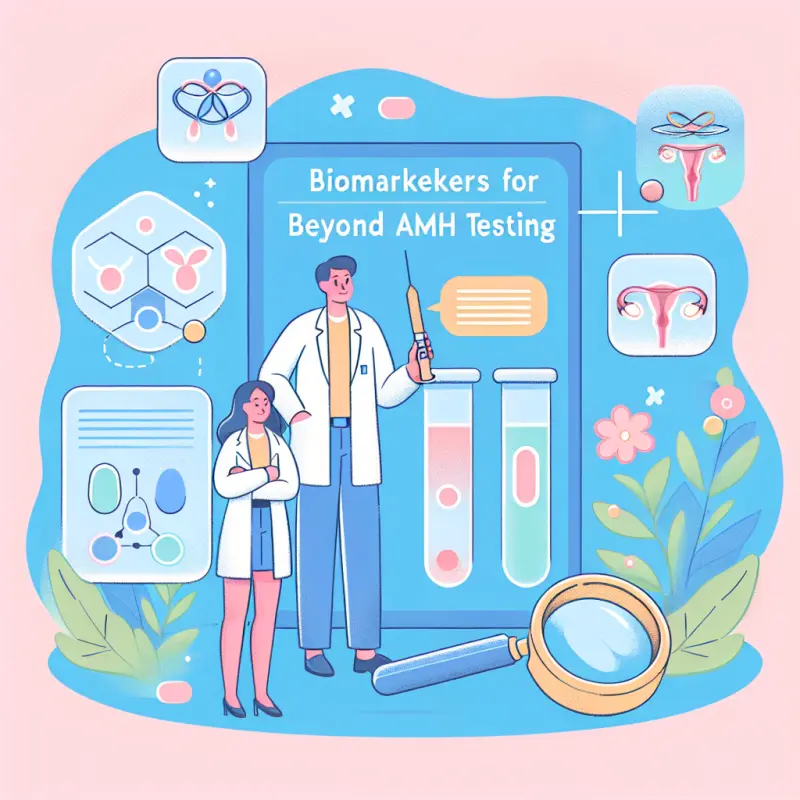Biomarkers for Ovarian Reserve: Beyond AMH Testing

Biomarkers for Ovarian Reserve: Beyond AMH Testing
Understanding ovarian reserve is crucial for assessing female fertility potential. Anti-Müllerian Hormone (AMH) has long been recognized as a reliable biomarker; however, recent research has highlighted the importance of exploring additional biomarkers to provide a more comprehensive picture. This article delves into the complexity of ovarian reserve, examining various biomarkers beyond AMH testing, and their implications for fertility assessment.
Introduction
Ovarian reserve refers to the pool of available follicles in the ovaries, which is a critical indicator of a woman's reproductive potential. Traditionally, AMH has been the go-to biomarker for assessing ovarian reserve due to its direct correlation with the quantity of antral follicles. However, relying solely on AMH testing can be limiting, as it does not provide a full spectrum of fertility-related insights. This article aims to explore additional biomarkers that, in conjunction with AMH, can offer a more nuanced understanding of ovarian reserve.
Understanding Ovarian Reserve
What is Ovarian Reserve?
- Definition: Ovarian reserve refers to the capacity of the ovary to provide egg cells capable of fertilization resulting in a healthy and successful pregnancy.
- Components: It encompasses both the quantity and quality of the remaining oocytes in the ovaries.
Importance of Assessing Ovarian Reserve
- Fertility Planning: Helps in fertility preservation decisions, especially for women delaying childbirth.
- IVF Outcomes: Predicts the response to ovarian stimulation in assisted reproductive technologies (ART).
- Menopausal Onset Prediction: Provides insight into the timing of menopause.
Traditional Biomarker: Anti-Müllerian Hormone (AMH)
Role of AMH in Ovarian Reserve
- Production: Secreted by granulosa cells of pre-antral and small antral follicles.
- Function: Inhibits the initial recruitment of follicles and decreases follicular sensitivity to FSH.
- Testing: Reflects the size of the remaining primordial follicle pool.
Limitations of AMH Testing
- Age Variability: AMH levels can vary widely among women of the same age.
- Lifestyle Factors: Influenced by obesity, smoking, and other lifestyle factors.
- Day-to-Day Variation: Although minor, AMH levels can fluctuate due to biological and technical factors.
Beyond AMH: Alternative Biomarkers
Follicle Stimulating Hormone (FSH)
- Role: High levels indicate diminished ovarian reserve as the pituitary gland compensates for reduced ovarian function.
- Limitations: Affected by intra-cycle variability; typically measured on day 3 of the menstrual cycle.
Antral Follicle Count (AFC)
- Technique: Assessed via transvaginal ultrasound.
- Benefits: Provides a direct count of visible follicles, correlating with ovarian reserve.
- Challenges: Requires specialized equipment and expertise; subject to observer variability.
Estradiol (E2)
- Function: Produced by ovarian follicles; elevated levels can mask elevated FSH, leading to false assessments.
- Utility: Offers insights into the hormonal environment but is not solely indicative of ovarian reserve.
Inhibin B
- Production: Secreted by granulosa cells; plays a role in feedback regulation of FSH.
- Assessment: Lower levels are associated with diminished ovarian reserve.
- Limitations: Not widely used due to variability and cost.
Luteinizing Hormone (LH)
- Role: Works in conjunction with FSH to stimulate follicular development.
- Significance: Elevated LH in relation to FSH can indicate polycystic ovary syndrome (PCOS) rather than direct ovarian reserve status.
Emerging Biomarkers
Ovarian Volume
- Measurement: Determined through ultrasound.
- Implication: Larger ovarian volume is generally associated with a higher antral follicle count and better ovarian reserve.
Growth Differentiation Factor 9 (GDF-9) and Bone Morphogenetic Protein 15 (BMP-15)
- Role: Involved in folliculogenesis and oocyte maturation.
- Research: Still under investigation but promising for providing insights into follicular health and oocyte quality.
Circulating microRNAs
- Function: Non-coding RNAs involved in gene regulation; potential biomarkers for various physiological and pathological conditions.
- Potential: Can reflect changes in ovarian function and reserve, though research is in early stages.
Comprehensive Approach to Assessing Ovarian Reserve
Integrating Multiple Biomarkers
- Holistic View: Combining AMH with FSH, AFC, and other markers provides a more comprehensive assessment.
- Customized Plans: Tailoring fertility treatment and interventions based on a broader range of data.
The Role of Genetic Testing
- Genetic Predispositions: Identifying mutations or polymorphisms that can affect ovarian reserve.
- Future Prospects: Personalized medicine approaches based on genetic profiles.
Clinical Implications and Guidelines
For Clinicians
- Evaluation Strategy: Adopt a multi-faceted approach to ovarian reserve testing.
- Counseling: Educate patients about the limitations and potential of various biomarkers.
- Monitoring: Regular updates on emerging research and guidelines.
For Patients
- Understanding Results: Encourage informed discussions with healthcare providers about test results.
- Lifestyle Modifications: Address modifiable factors that can influence ovarian reserve.
Conclusion
While AMH remains a cornerstone in assessing ovarian reserve, expanding the scope to include additional biomarkers offers a richer, more detailed understanding of a woman's reproductive health. By integrating traditional and emerging biomarkers, healthcare providers can tailor fertility assessments and interventions more effectively. As research progresses, the hope is to refine these tools further, paving the way for improved fertility outcomes and personalized reproductive care.
In the rapidly evolving landscape of reproductive medicine, staying abreast of the latest developments in biomarker research is crucial. Ultimately, a comprehensive approach not only enhances fertility treatment efficacy but also empowers women with knowledge about their reproductive futures.